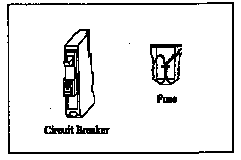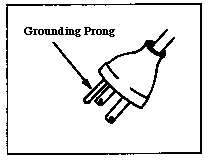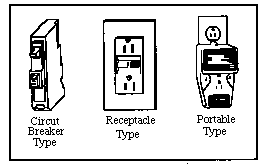Table
of Contents
Introduction
What to Do In Case of An Accident
|
Electricity, or electric current, is the flow of electrons from one atom to another in any material. Materials that allow electricity to flow easily are called conductors. Most metals, such as copper and aluminum, make good conductors of electricity. Insulators are materials that do not allow electricity to flow through them. Good examples of insulators are glass, plastic, and rubber. Unfortunately, our bodies can allow current to pass through them, causing anywhere from a mild tingling sensation to cardiac arrest and burning.
There are many ways in which electrical accidents happen. Hazards result from the degradation of electrical wire insulation due to rodents, weathering, or normal wear, improper wiring, improper wire size or type, and corrosion of electrical connections, for example. In addition to these normal hazards, agricultural workers are particularly subject to the hazards of electricity because tall equipment, such as grain augers, combines, and raised dump truck beds can become entangled in overhead power lines. Accidents have also occurred with overhead power lines when moving irrigation pipe. Agricultural buildings are subject to dusty, moist and corrosive environments, making them especially troublesome when using electricity. Electricity was the seventh largest cause of deaths on farms in 1988, and causes unknown amounts of property and livestock loss every year. Fortunately, there are several devices and methods that can be employed to protect yourself, your animals, and your property.
Return to Table of Contents
Fuses and circuit breakers have a numbered rating system which indicates the maximum amount of current that they will allow through. The fuses and circuit breakers are matched to the size of the electrical wires used in the system. Thus, fuses should always be replaced with a new fuse of the same rating. A higher rated fuse will not offer any protection if the system was to draw too much electricity and could result in an electrical fire or damage to your equipment. A smaller rated fuse will cause the circuit to blow the fuse more frequently, leading to your aggravation and the temptation to bypass the system. If absolutely necessary, use a smaller rated fuse for temporary power, but never a larger one.
Return to Table of Contents
 Another important safety feature is "grounding." Grounding
occurs when a ground wire is connected from ground potential
to the frame of an electrical device. Grounding is not necessary
for a circuit to work, it is only there for the protection
of individuals from stray current. In a normal circuit, electricity
flows from the "hot" wire (which is usually black) to the
electrical device and back to ground potential through the
neutral wire (which is usually white or gray). A ground wire
(which is usually bare or green) is provided so there can
be an alternate path for the electricity to flow back to ground
potential if an electrical short occurs. For example, if the
wires inside an electrical device have become worn or the
insulation broken down such that the hot wire makes contact
with the case on the device, then the current could possibly
flow through the individual using the device back to ground.
If a ground wire is present, however, the current will take
the path of least resistance and flow through the ground wire
back to ground instead of flowing through the individual causing
an electrical shock.
Another important safety feature is "grounding." Grounding
occurs when a ground wire is connected from ground potential
to the frame of an electrical device. Grounding is not necessary
for a circuit to work, it is only there for the protection
of individuals from stray current. In a normal circuit, electricity
flows from the "hot" wire (which is usually black) to the
electrical device and back to ground potential through the
neutral wire (which is usually white or gray). A ground wire
(which is usually bare or green) is provided so there can
be an alternate path for the electricity to flow back to ground
potential if an electrical short occurs. For example, if the
wires inside an electrical device have become worn or the
insulation broken down such that the hot wire makes contact
with the case on the device, then the current could possibly
flow through the individual using the device back to ground.
If a ground wire is present, however, the current will take
the path of least resistance and flow through the ground wire
back to ground instead of flowing through the individual causing
an electrical shock.

Never destroy or cut off the round grounding prong on a plug to fit it into a socket or extension cord that does not accommodate the prong. If the equipment you are working with does not have a ground wire, then consider rewiring the device to accommodate the grounding feature. Another option is to use double insulated tools. These tools have an air space around the device to help insulate you from an electrical shock.
Return to Table of Contents
 Another protective device that can be used is called a Ground
Fault Circuit Interrupter, commonly referred to as a GFI or
GFCI. This device is meant to protect human beings from electrical
shocks due to faulty electrical equipment. A GFCI works by
monitoring the current flow to an electrical device and comparing
it to the amount of current flowing back. If there is a difference
between these two values, this means that some electricity
is flowing back to ground through a path other than the wire.
This is called a "ground fault" and when the GFCI detects
this, it stops current flow altogether in the circuit. Consider
the previous example in which the wires inside an electrical
device have become worn or damaged so that the hot wire makes
contact with the casing. If a person were to use the tool,
then electricity could possibly flow through the individual
back to ground. When a GFCI detects this situation, it stops
current flow before harmful amounts of electricity flow through
the individual. Electricity will flow through an individual
easier if the person is working in wet or damp conditions,
which is why it is recommended that GFCI's be installed in
all bathrooms, kitchens laundry rooms, garages, and other
buildings where moisture can be a problem. The protection
from grounding and from a GFCI are similar. However, if your
equipment does not have a ground wire, then a GFCI is your
only form of protection from faulty equipment. GFCI's also
offer protection if the grounding mechanisms are faulty.
Another protective device that can be used is called a Ground
Fault Circuit Interrupter, commonly referred to as a GFI or
GFCI. This device is meant to protect human beings from electrical
shocks due to faulty electrical equipment. A GFCI works by
monitoring the current flow to an electrical device and comparing
it to the amount of current flowing back. If there is a difference
between these two values, this means that some electricity
is flowing back to ground through a path other than the wire.
This is called a "ground fault" and when the GFCI detects
this, it stops current flow altogether in the circuit. Consider
the previous example in which the wires inside an electrical
device have become worn or damaged so that the hot wire makes
contact with the casing. If a person were to use the tool,
then electricity could possibly flow through the individual
back to ground. When a GFCI detects this situation, it stops
current flow before harmful amounts of electricity flow through
the individual. Electricity will flow through an individual
easier if the person is working in wet or damp conditions,
which is why it is recommended that GFCI's be installed in
all bathrooms, kitchens laundry rooms, garages, and other
buildings where moisture can be a problem. The protection
from grounding and from a GFCI are similar. However, if your
equipment does not have a ground wire, then a GFCI is your
only form of protection from faulty equipment. GFCI's also
offer protection if the grounding mechanisms are faulty.
There are three different types of GFCI's available. The most common type is the GFCI breaker. These are used instead of conventional breakers to protect everything on the circuit. There are also GFCI outlets that can easily replace conventional outlets. These will offer protection for everything plugged into them. There are also portable types that can be plugged into any outlet. The device you want to use is then plugged into the GFCI. All GFCI's are equipped with test buttons which intentionally cause a ground fault to insure the device is working properly. It is recommended that all GFCI's be tested every month.
Return to Table of Contents
Even with all of these protective devices in place, you can still get shocked if you accidentally touch both the hot and neutral wires of a live circuit. This is different from a ground fault because during a ground fault only some of the current in the circuit will flow through you to ground. If you touch both hot and neutral wires then all of the current in the system will flow through you and your body will act as a normal electrical device. Therefore, there are additional precautions you need to take to prevent accidental death and injury.
Return to Table of Contents
Return to Table of Contents
Return to Table of Contents
Another special problem with electricity on the farm is the dusty, moist and corrosive environments of most livestock houses. There are waterproof, dust proof, and even explosion proof electrical boxes, outlets, and motors available for use in the uniquely troublesome environments of livestock facilities. These materials ensure safe and reliable use of electricity throughout your farm.
Return to Table of Contents
What to
do in Case of an Accident
So
far we have focused on ways to prevent electrical accidents
and misuse. If an accident still occurs, then certain steps
should be taken.
Return to Table of Contents
October, 1996
Disclaimer and Reproduction Information: Information in NASD does not represent NIOSH policy. Information included in NASD appears by permission of the author and/or copyright holder. More